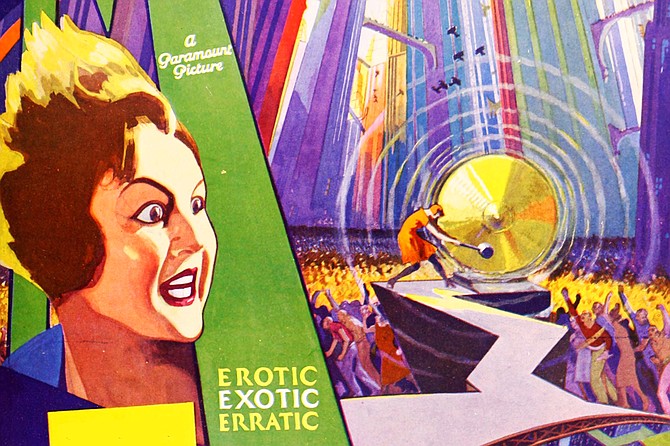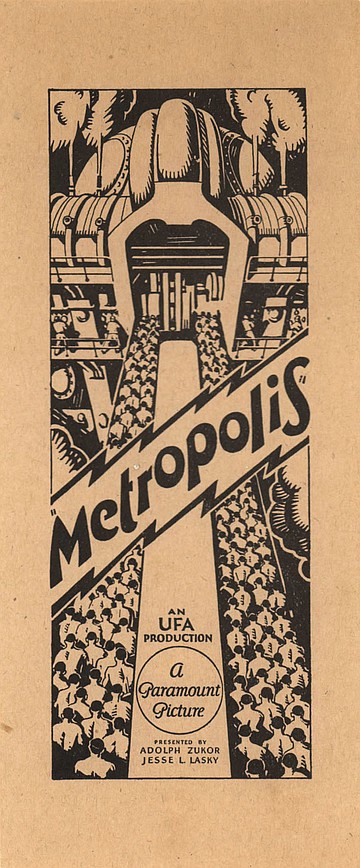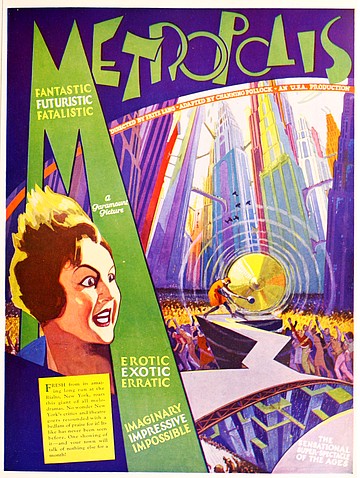 Facebook
Facebook
 X
X
 Instagram
Instagram
 TikTok
TikTok
 Youtube
Youtube

It’s all out there somewhere: the Pomona preview print of The Magnificent Ambersons; the missing reels of Eric von Stroheim’s Greed; Lon Chaney’s uncut London After Midnight; even the pie fight from Dr. Strangelove is lounging in a corner of some remote film exchange or museum. Such was the case for Fritz Lang’s Metropolis, a science-fiction cornerstone that for years existed only in truncated form.
Metropolis (1927)
The catalyst for this column came from a friend’s tweet, which asked us readers to name the one film that over the years, and through all the various home video editions, we’ve owned the most copies of. Not all video pressings are alike, and nothing illustrated the proverb better than Metropolis. First came Barnes & Noble’s “exclusive” VHS pressing, which appeared to have been shot with shoe polish smeared on the lens. An upgrade to the Kino restored print was followed by a used VHS copy of Giorgio Moroder’s 1984 sparkling revival. Even though I didn’t own a player, a Laserdisc was purchased to screen for my students. The 2001 DVD release that was heralded as the “definitive” version wasn’t. The 2010 release runs 148 minutes. That brings the total to seven. All it would take is one persistent archivist or nosy film student to pop open the right can for me to gladly make it eight.
Eighty-three years after its release, Fritz Lang’s groundbreaking dystopian sci-fi epic continued to prove that there’s gold in them thar film exchanges. Rumors began circulating in May 2008 that an uncut, 131-minute print of Orson Welles’ The Magnificent Ambersons was discovered at the São Paulo Cinematheque. A fan comment posted on the Turner Classic Movies website added, “Cans labeled correctly but ignored by over-worked local preservation staff which assumed it was regular print of film.” Two months after the rumor proved to be a false alarm, word arrived that members of the Museo del Cine Pablo C. Ducros Hicken in Buenos Aires had found a 16mm negative of what was thought to be long-lost scenes from Fritz Lang’s 21st-century masterwork.

The original running time was 210 minutes. Adjusted for inflation, the budget would run upwards of $200 million. The film was so big, it took three studios to create it. Produced as part of the Parufamet Agreement, a partnership between American studios Paramount and M-G-M and Germany’s combative collaborator, Universum Film AG (UFA), it was, according to Zeit Online, “the most expensive German film ever made. It was intended to be a major offensive against Hollywood. However the film flopped with critics and audiences alike.”
Blotting flop sweat, American reps from Paramount, dissatisfied with Lang’s stylish complexities, took scissors and started snipping away at his creation, bringing the running time down to 153 minutes. The following months saw the film whittled down to 118 minutes. The plot was restructured to the point of oversimplification, causing many crucial scenes to be snipped. All that remained of the original Metropolis was an incomplete original negative and various copies of shortened and reedited release prints. The last cut took place in 1936, bringing its length down to 91 minutes. For eighty years, over half of Lang’s original vision was considered missing in action.

The production took two years to complete, and featured more than “37,000 extras including 25,000 men, 11,000 women, 1,100 bald men, 750 children, 100 dark-skinned people, and 25 Asians,” according to a press release at the time. Film lovers never gave up hope. I was in my early teens when a television screening introduced me to the film. Years later, a friend screened a scratchy Super8 Blackhawk Films transfer. I eventually caught up with the film in 35mm and screened it on 16mm and LaserDisc for my film students. The running time of each version varied somewhere between 85 and 93 minutes. But while not one frame from the uncut version of The Magnificent Ambersons has ever managed to surface over the years, new pieces of Metropolis kept popping up from time to time.
The national Film archive of the German Democratic Republic began their restoration efforts in the 1960s. In the 1980s, the short version was digitally restored by Martin Koerber on behalf of the Friedrich-Wilhelm-Murnau-Stiftung. In 1984, composer Giorgio Moroder put his American Gigolo proceeds to good work by restoring the short version to its original visual splendor complete with color tinting according to Lang’s specifications. The only downside was the insufferable score in which Moroder wrapped his gift.
A copy of the uncut print passed into the collection of the Museo del Cine in Buenos Aires in 1992. The Associated Press reported that 30 years ago, Argentine film fanatic Fernando Martín Peña heard about a man who had propped up a broken projector for “hours” to screen Metropolis. This made no sense to Peña, because the only version he knew of ran just 90 minutes. For years, he begged Buenos Aires’ museums to check their archives for a longer version.

Paula Félix-Didier became museum curator in January 2008. Her ex-husband, director of the film department of the Museum of Latin American Art, first caught wind of the discovery from the manager of a cinema club. Together, they took a look at the film in her archive and discovered the missing scenes. The new material was shown to journalists for the first time in decades, and Ms. Felix-Didier said theirs is the only “complete” copy of Lang’s film.
Normally, it is difficult to spot where new footage begins and old leaves off, but in this case, the scratched up 16mm dupe print makes it easy. The found footage is woven throughout the feature, in some cases revealing entire subplots that were lopped off.

It is important to note that the “new” shots are not merely extensions of previously existing scenes. “It restores the original editing,” says The Association of Moving Image Archivists’ Martin Koerber, “restoring the balance between the characters and subplots that remained and those that were excised.” Perhaps the greatest revelation comes from added insight into a key conflict concerning “Hel,” our hero’s late mother, who played lover to both his father and the mad scientist who helped design the futuristic utopia. American playwright Channing Pollock, hired to rewrite the film’s title cards, believed that “Hel” was too close to “Hell” to be accepted by American filmgoers.
No one has seen the complete 210-minute version of Lang’s futuristic tale of man vs. machine since its May 1927 premier. While the 2010 release is not the definitive cut (with overture and walk-off music), it’s safe to say the most important silent film in German history and arguably the most influential science fiction film of all time can no longer be considered lost.


It’s all out there somewhere: the Pomona preview print of The Magnificent Ambersons; the missing reels of Eric von Stroheim’s Greed; Lon Chaney’s uncut London After Midnight; even the pie fight from Dr. Strangelove is lounging in a corner of some remote film exchange or museum. Such was the case for Fritz Lang’s Metropolis, a science-fiction cornerstone that for years existed only in truncated form.
Metropolis (1927)
The catalyst for this column came from a friend’s tweet, which asked us readers to name the one film that over the years, and through all the various home video editions, we’ve owned the most copies of. Not all video pressings are alike, and nothing illustrated the proverb better than Metropolis. First came Barnes & Noble’s “exclusive” VHS pressing, which appeared to have been shot with shoe polish smeared on the lens. An upgrade to the Kino restored print was followed by a used VHS copy of Giorgio Moroder’s 1984 sparkling revival. Even though I didn’t own a player, a Laserdisc was purchased to screen for my students. The 2001 DVD release that was heralded as the “definitive” version wasn’t. The 2010 release runs 148 minutes. That brings the total to seven. All it would take is one persistent archivist or nosy film student to pop open the right can for me to gladly make it eight.
Eighty-three years after its release, Fritz Lang’s groundbreaking dystopian sci-fi epic continued to prove that there’s gold in them thar film exchanges. Rumors began circulating in May 2008 that an uncut, 131-minute print of Orson Welles’ The Magnificent Ambersons was discovered at the São Paulo Cinematheque. A fan comment posted on the Turner Classic Movies website added, “Cans labeled correctly but ignored by over-worked local preservation staff which assumed it was regular print of film.” Two months after the rumor proved to be a false alarm, word arrived that members of the Museo del Cine Pablo C. Ducros Hicken in Buenos Aires had found a 16mm negative of what was thought to be long-lost scenes from Fritz Lang’s 21st-century masterwork.

The original running time was 210 minutes. Adjusted for inflation, the budget would run upwards of $200 million. The film was so big, it took three studios to create it. Produced as part of the Parufamet Agreement, a partnership between American studios Paramount and M-G-M and Germany’s combative collaborator, Universum Film AG (UFA), it was, according to Zeit Online, “the most expensive German film ever made. It was intended to be a major offensive against Hollywood. However the film flopped with critics and audiences alike.”
Blotting flop sweat, American reps from Paramount, dissatisfied with Lang’s stylish complexities, took scissors and started snipping away at his creation, bringing the running time down to 153 minutes. The following months saw the film whittled down to 118 minutes. The plot was restructured to the point of oversimplification, causing many crucial scenes to be snipped. All that remained of the original Metropolis was an incomplete original negative and various copies of shortened and reedited release prints. The last cut took place in 1936, bringing its length down to 91 minutes. For eighty years, over half of Lang’s original vision was considered missing in action.

The production took two years to complete, and featured more than “37,000 extras including 25,000 men, 11,000 women, 1,100 bald men, 750 children, 100 dark-skinned people, and 25 Asians,” according to a press release at the time. Film lovers never gave up hope. I was in my early teens when a television screening introduced me to the film. Years later, a friend screened a scratchy Super8 Blackhawk Films transfer. I eventually caught up with the film in 35mm and screened it on 16mm and LaserDisc for my film students. The running time of each version varied somewhere between 85 and 93 minutes. But while not one frame from the uncut version of The Magnificent Ambersons has ever managed to surface over the years, new pieces of Metropolis kept popping up from time to time.
The national Film archive of the German Democratic Republic began their restoration efforts in the 1960s. In the 1980s, the short version was digitally restored by Martin Koerber on behalf of the Friedrich-Wilhelm-Murnau-Stiftung. In 1984, composer Giorgio Moroder put his American Gigolo proceeds to good work by restoring the short version to its original visual splendor complete with color tinting according to Lang’s specifications. The only downside was the insufferable score in which Moroder wrapped his gift.
A copy of the uncut print passed into the collection of the Museo del Cine in Buenos Aires in 1992. The Associated Press reported that 30 years ago, Argentine film fanatic Fernando Martín Peña heard about a man who had propped up a broken projector for “hours” to screen Metropolis. This made no sense to Peña, because the only version he knew of ran just 90 minutes. For years, he begged Buenos Aires’ museums to check their archives for a longer version.

Paula Félix-Didier became museum curator in January 2008. Her ex-husband, director of the film department of the Museum of Latin American Art, first caught wind of the discovery from the manager of a cinema club. Together, they took a look at the film in her archive and discovered the missing scenes. The new material was shown to journalists for the first time in decades, and Ms. Felix-Didier said theirs is the only “complete” copy of Lang’s film.
Normally, it is difficult to spot where new footage begins and old leaves off, but in this case, the scratched up 16mm dupe print makes it easy. The found footage is woven throughout the feature, in some cases revealing entire subplots that were lopped off.

It is important to note that the “new” shots are not merely extensions of previously existing scenes. “It restores the original editing,” says The Association of Moving Image Archivists’ Martin Koerber, “restoring the balance between the characters and subplots that remained and those that were excised.” Perhaps the greatest revelation comes from added insight into a key conflict concerning “Hel,” our hero’s late mother, who played lover to both his father and the mad scientist who helped design the futuristic utopia. American playwright Channing Pollock, hired to rewrite the film’s title cards, believed that “Hel” was too close to “Hell” to be accepted by American filmgoers.
No one has seen the complete 210-minute version of Lang’s futuristic tale of man vs. machine since its May 1927 premier. While the 2010 release is not the definitive cut (with overture and walk-off music), it’s safe to say the most important silent film in German history and arguably the most influential science fiction film of all time can no longer be considered lost.
Comments